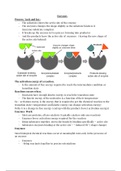Bio104 Study guides, Class notes & Summaries
Looking for the best study guides, study notes and summaries about Bio104? On this page you'll find 26 study documents about Bio104.
Page 3 out of 26 results
Sort by
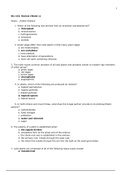
-
Bio 104 week 1-2 review book Campbell Reece sum 2019
- Answers • 7 pages • 2019
- Available in package deal
-
- $3.99
- + learn more
Questions and answers for exam review 1-2nd week of semester 2 Which of the following was derived from an ancestral cyanobacterium? a. chloroplast b. mitochondrion c. hydrogenosome d. mitosome e. protists 2. Green algae differ from land plants in that many green algae a. are heterotrophs. b. are unicellular. c. have plastids. d. have alternation of generations. e. have cell walls containing cellulose. 3. The most recent common ancestor of all land plants was probably similar to modern...
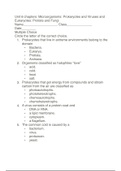
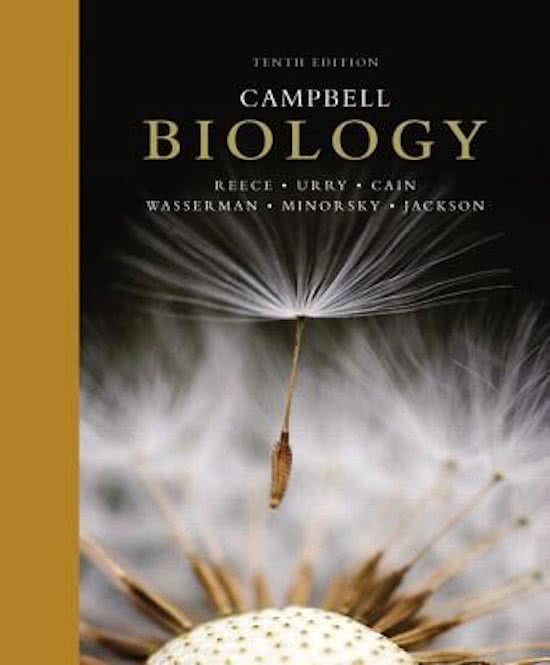
-
Bio 104 review Reece, Campbell 2017
- Answers • 5 pages • 2019
- Available in package deal
-
- $7.49
- + learn more
Campbell Reese Biology ch 40-43 final exam study guide questions and answers After surgical removal of the gallbladder, a person must be careful to limit intake of a. starch b. protein c. sugar d. fat e. water Chapter 42 26. What would happen if the amount of interstitial fluid surrounding the capillary beds of the lungs were to increase significantly? a. The amount of CO2 entering the lungs from the blood would increase. b. The amount of CO2 entering the blood from the lungs would in...
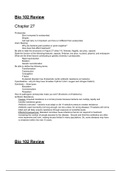

-
Bio+104+Review+Ch+27-39 Reece, Campbell Summer 2019
- Exam (elaborations) • 17 pages • 2019
- Available in package deal
-
- $5.49
- + learn more
Prokaryotes Size (compared to eukaryotes) Shapes Cell wall (why is it important, and how is it different than eukaryotes) Gram Staining Why are bacteria gram-positive or gram-negative? How does that affect treatment? Be able to label the structures on Figure 27 (slide 14): fimbriae, flagella, sex pilus, capsule State the function of the following features: capsule, fimbriae, sex pilus, nucleoid, plasmid, and endospore What are the three factors contributing to genetic diversity in prokaryotes...
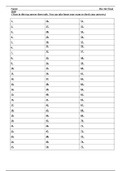

-
Bio 104 exam 2 questions Reece, Campbell summer 2018
- Exam (elaborations) • 17 pages • 2019
- Available in package deal
-
- $7.49
- + learn more
1. Connective tissues have a. many densely packed cells without an extracellular matrix b. a supporting material such as chondroitin sulfate c. an epithelial origin d. relatively few cells and a large amount of extracellular matrix. e. the ability to transport electrical impulses 2. All skeletal muscle fibers are both a. smooth and involuntary b. smooth and unbranched c. striated and voluntary d. smooth and voluntary e. striated and branched 3. The epithelium best adap...
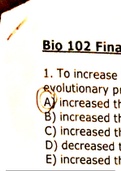

-
Bio Final exam review REESE CAMPBELL SUM 2019 q's and answers
- Exam (elaborations) • 14 pages • 2019
- Available in package deal
-
- $4.49
- + learn more
Body fluids of an osmoconformer would be ________ with its _________ environment. a. hyperosmotic; freshwater b. isotonic; freshwater c. hyperosmotic; saltwater d. isoosmotic; saltwater e. hyposmotic; saltwater 2. A freshwater fish was accidently placed in salt water, and died after several minutes. Why? a. Loss of water by osmosis in cells in vital organs resulting in cell death and organ failure. b. Salt diffused into all of the fish’s cells causing them to swell and lyse. c. The kidneys...
discusses lecture on enzymes and actived sites in bio

How much did you already spend on Stuvia? Imagine there are plenty more of you out there paying for study notes, but this time YOU are the seller. Ka-ching! Discover all about earning on Stuvia



